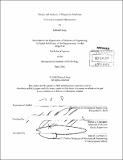| dc.contributor.advisor | Martin L. Culpepper. | en_US |
| dc.contributor.author | Sung, Edward, S.M. Massachusetts Institute of Technology | en_US |
| dc.contributor.other | Massachusetts Institute of Technology. Dept. of Mechanical Engineering. | en_US |
| dc.date.accessioned | 2012-01-30T16:55:39Z | |
| dc.date.available | 2012-01-30T16:55:39Z | |
| dc.date.copyright | 2010 | en_US |
| dc.date.issued | 2011 | en_US |
| dc.identifier.uri | http://hdl.handle.net/1721.1/68861 | |
| dc.description | Thesis (S.B.)--Massachusetts Institute of Technology, Dept. of Mechanical Engineering, June 2011. | en_US |
| dc.description | "June 2011." Cataloged from PDF version of thesis. | en_US |
| dc.description | Includes bibliographical references (p. 44). | en_US |
| dc.description.abstract | In this paper, the design and testing of an ankle rehabilitation device is presented. The purpose of the research done is to provide physicians with a diagnostics tool that can quantitatively measure the severity of an injury by measuring the ankle joint's functional output. Torque and power output have been shown to be correlated with functional performance of the ankle joint. The device can measure torque and power output over the full range of motion of the ankle joint complex. Such a device has the potential to enable more accurate diagnoses and improve the efficacy of treatment and rehabilitation. The device allows rotation about the three orthogonal axes in the Cartesian plane. The rotations are linked in series to simulate ankle subjoint coupling. Cartwheel flexures with strain gages are aligned with the rotational axes and used as torque sensors. Strain gages are placed in a Wheatstone bridge circuit to mitigate environmental factors. Trials measured torque of the right ankle joint of test subjects from a standing position. Results show that the coupling of the two modes of ankle joint rotation (plantarflexion/dorsiflexion and inversion/eversion) are dependent on a subject's own development. | en_US |
| dc.description.statementofresponsibility | by Edward Sung. | en_US |
| dc.format.extent | 47 p. | en_US |
| dc.language.iso | eng | en_US |
| dc.publisher | Massachusetts Institute of Technology | en_US |
| dc.rights | M.I.T. theses are protected by
copyright. They may be viewed from this source for any purpose, but
reproduction or distribution in any format is prohibited without written
permission. See provided URL for inquiries about permission. | en_US |
| dc.rights.uri | http://dspace.mit.edu/handle/1721.1/7582 | en_US |
| dc.subject | Mechanical Engineering. | en_US |
| dc.title | Design and analysis of diagnostic machines utilizing compliant mechanisms | en_US |
| dc.type | Thesis | en_US |
| dc.description.degree | S.B. | en_US |
| dc.contributor.department | Massachusetts Institute of Technology. Department of Mechanical Engineering | |
| dc.identifier.oclc | 773196233 | en_US |
